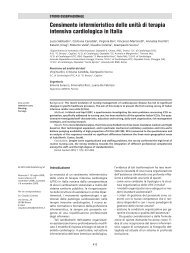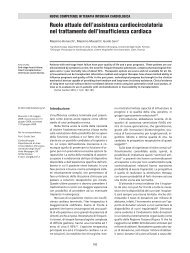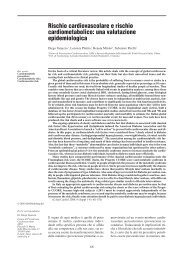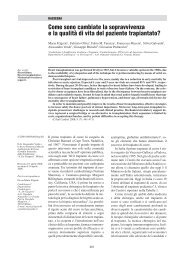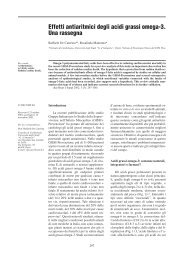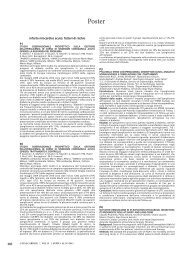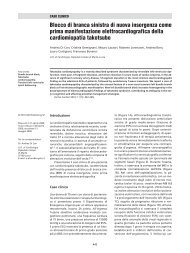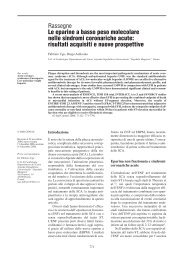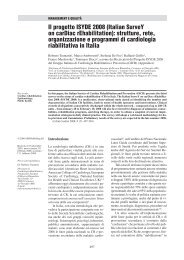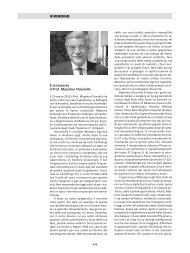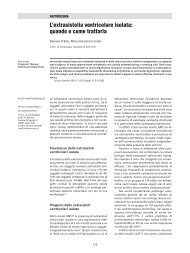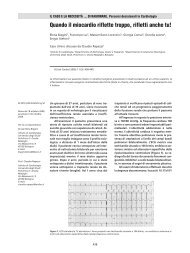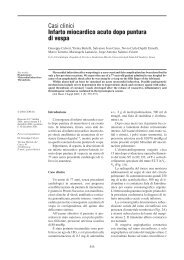G Ital Car<strong>di</strong>ol Vol 8 Suppl 2-5 2007 car<strong>di</strong>ovascular morbi<strong>di</strong>ty and mortality in <strong>di</strong>abetic patients. Strain (S) and strain rate (SR) echocar<strong>di</strong>ography are emerging ultrasound techniques that improve the accuracy and reproducibility of conventional echocar<strong>di</strong>ography stu<strong>di</strong>es. Aim of this study. To test the ability of atrial strain to identify <strong>di</strong>astolic dysfunction grade and heart failure functional signs. Materials and methods. We stu<strong>di</strong>ed 100 subjects, whose 50 (28M, 22F, mean age: 62 years) with CAD assessed by coronary angiography with <strong>di</strong>abetes mellitus and without valvular <strong>di</strong>sease, hypertension, <strong>di</strong>lated or hypertrophic car<strong>di</strong>omyopathy or congenital heart <strong>di</strong>sease and 50 (30M, 20F) controls. Echocar<strong>di</strong>ography System Seven GE with TVI function on each patients. A M- mode, bi<strong>di</strong>mensional, Color Doppler, Pulsed and Continuous Doppler (transmitral, transtricuspid and pulmonary vein flow) and TVI echocar<strong>di</strong>ographic study was performed. Left (LA) and right atrial (RA) <strong>di</strong>ameters, left and right atrium EF(%) and propagation velocity of early <strong>di</strong>astolic flow (Pv), at Colour M- mode Doppler of transmitral inflow, were measured. Pulmonary artery wedge pressure was calculated by E/Ea. Peak systolic tissue atrial S and SR were evaluated in 4 and 2 chamber views at the level of the septal, lateral, anterior and inferior atrial walls near the roof, and at the level of the right atrial free wall near the roof. Results. A significant <strong>di</strong>rect correlation was found between pulmonary artery wedge pressure and left and right atrial <strong>di</strong>ameters (P=0,005; R=0,63), left and right atrial volumes (P=0,004; R=0,73), early <strong>di</strong>astolic velocity (E wave) and late <strong>di</strong>astolic velocity (A wave) (P=0,003; R=0,64). A <strong>di</strong>rect correlation was found between <strong>di</strong>astolic reverse flow duration (Ar dur) and left atrial end-<strong>di</strong>astolic and end-systolic volumes (P=0,001; R=0,74). The myocar<strong>di</strong>al atrial S and SR were found to be significantly (p=0,003) lower for each wall (both left and right atrium) in patients with <strong>di</strong>abetes than in controls. A significant inverse correlation was found between left and right atrial S and SR (P=0,03; R=-0,71) and pulmonary artery wedge pressure and left and right atrial EF. An inverse correlation was found between pulmonary artery wedge pressure and propagation velocity of early <strong>di</strong>astolic flow (Pv) (P=0,003; R=-0,63) and a <strong>di</strong>rect correlation between pulmonary artery wedge pressure and mitral forward A wave (A) (P=0,004; R=0,72). Conclusions. Atrial strain (S) and strain rate (SR) and <strong>di</strong>fferent TVI parameters identify elevated pulmonary artery wedge pressure and <strong>di</strong>astolic dysfunction grade in <strong>di</strong>abetic patients with CAD and authorize aggressive therapeutic intervention in such patients. C44 PATIENTS AFFECTED BY HEART FAILURE WITH PEAK OXYGEN CONSUMPTION BETWEEN 10-18 ML/KG/MIN: CAN CARDIOPULMONARY TEST PROVIDE ADDITIONAL PARAMETERS FOR A BETTER PROGNOSTIC STRATIFICATION? M. Merlo, D. Clama, E. Berton, A. Magagnin, A. Pivetta, S. Pyxaras, G. Secoli, M. Moretti, A. Di Lenarda, G. Sinagra Car<strong>di</strong>ovascular Department, “Ospedali Riuniti” and University of Trieste, Trieste, Italy Background. Peak oxygen consumption (VO2) an old-time classic parameter used to stratify HF patients (pts) was recently combined to VE/VCO2 slope, in order to improve heart transplant selection criteria. The lack of prognostic factors is particularly evident in the subgroup of pts with interme<strong>di</strong>ate grade of risk (i.e. with a peak VO2 between 10 and 18 ml/kg/min). We sought to analyse the pre<strong>di</strong>ctive role of aerobic indexes obtained during Car<strong>di</strong>opulmonary Exercise Testing (CPET) in pts affected by i<strong>di</strong>opathic <strong>di</strong>lated car<strong>di</strong>omyopathy (IDC) with a peak VO2 between 10 and 18 ml/kg/min. Methods. We analyzed 171 IDC pts enrolled in the Trieste Heart Muscle Disease Registry who underwent CPET from 1997 and 2005. Among these, 97 pts had a peak VO2 between 10 and 18 ml/kg/min (mean age 48±10 yrs, males 71%, NYHA class III-IV 20%, left ventricle ejection fraction (LVEF) 0.30±0.11, peak VO2 14±2 ml/kg/min, ACE-inhibitors 93%, beta-blockers 88%). Combined endpoint was considered Car<strong>di</strong>ovascular Death/Major Ventricular Arrhythmias/ Car<strong>di</strong>ovascular Hospitalizations at 1 year. Results. At univariate analysis, pts who satisfied the end point criteria at oneyear, in comparison with those who <strong>di</strong>d not, showed a trend towards more advanced functional NYHA class, lower LVEF and lower circulatory power. The only parameter significantly associated to our combined end-point resulted a higher VE/VCO2 slope (34±7 vs 29±4, p=0.003). At multivariate analysis VE/VCO2 slope was selected as an independent pre<strong>di</strong>ctor of one-year car<strong>di</strong>ovascular endpoint (for a 2-unit increase: O.R.1.41, 95% I.C. 1.08-1.85, p=0.012) together with LVEF (for a 5-point decrease: O.R.1.71, 95% I.C. 1.08- 2.71, p=0.025). At ROC curves VE/VCO2 slope had an AUC of 0.694 for our study end-point with a cut-off value of 28 (Figure 1). Conclusions. In pts classified at interme<strong>di</strong>ate risk accor<strong>di</strong>ng to peak VO2, VE/VCO2 slope may add prognostic power to identify pts at higher risk of early heart transplant in<strong>di</strong>cation. Prognosi dello scompenso car<strong>di</strong>aco C43 RUOLO PROGNOSTICO ADDITIVO DEL TEST CARDIOPOLMONARE NELLA STRATIFICAZIONE DEL RISCHIO DEL PAZIENTE ANZIANO CON SCOMPENSO CARDIACO CRONICO A.B. Scardovi, R. De Maria, C. Coletta, S. Perna, N.A. Aspromonte, M. Feola, G.L. Rosso, P. D’Errigo, A. Pimpinella, A. Carunchio, B. Krakowska, T. Di Giacomo, R. Ricci, V. Ceci Ospedale S. Spirito, Roma, Ospedale S. Andrea, Roma Premessa. La stratificazione del rischio nei pazienti (pz) anziani affetti da scompenso car<strong>di</strong>aco (SC) è particolarmente complessa. Infatti, nonostante i recenti progressi nel trattamento dello SC, l’incidenza <strong>di</strong> mortalità e morbilità rimangono alte in questo tipo <strong>di</strong> popolazione. Il test car<strong>di</strong>opolmonare (CPX) è uno degli strumenti principali per stratificare la prognosi, ma i parametri normalmente utilizzati sono derivati dall’osservazione <strong>di</strong> pz relativamente giovani e <strong>di</strong> sesso maschile. Allo stato attuale non si hanno informazioni esaurienti circa il ruolo prognostico del CPX, in aggiunta ai parametri clinici, ecocar<strong>di</strong>ografici e <strong>di</strong> laboratorio sui quali normalmente viene formulata la valutazione prognostica, in pz anziani con SC. L’obiettivo del nostro lavoro è stato <strong>di</strong> verificare se il CPX fosse in grado <strong>di</strong> affinare il giu<strong>di</strong>zio prognostico in una popolazione <strong>di</strong> pz anziani con SC lieve-moderato, già valutata con i parametri tra<strong>di</strong>zionali. Meto<strong>di</strong> e Risultati. 223 pz anziani, consecutivi, stabili, affetti da SC con terapia ottimizzata, sono stati valutati in regime ambulatoriale sottoponendoli ad esami ematici <strong>di</strong> routine, dosaggio del BNP plasmatico, ecocar<strong>di</strong>ogramma Doppler e CPX massimale. La me<strong>di</strong>ana dell’età era 75 (68, 90) anni, il 32% erano donne, la classe funzionale NYHA era I-III. La frazione <strong>di</strong> eiezione me<strong>di</strong>a ecocar<strong>di</strong>ografica del ventricolo sinistro era 40±13%. Un quoziente respiratorio al picco dell’esercizio (RER) ≥1.05 veniva considerato come un in<strong>di</strong>ce <strong>di</strong> massimalità dell’esercizio svolto. La me<strong>di</strong>ana del BNP era 140 [10, 1322] pg/ml; un pattern <strong>di</strong> riempimento del ventricolo sinistro <strong>di</strong> tipo restrittivo era presente in 40 pazienti (18%). Al CPX l’80% dei pz aveva raggiunto un RER ≥1.05, la me<strong>di</strong>ana del consumo <strong>di</strong> ossigeno al picco dell’esercizio era 12 [4.8, 20.7] ml/kg/min ed una risposta iperventilatoria all’esercizio [EVR, espressa come la pendenza della retta <strong>di</strong> regressione che correla la ventilazione con la produzione <strong>di</strong> CO 2 (VE/VCO2 slope) >33] veniva rilevata in 77 pz (35%) Durante un periodo <strong>di</strong> osservazione <strong>di</strong> 684 giorni (range 38-1928) 87 pz morirono o furono ricoverati per instabilizzazione delle con<strong>di</strong>zioni <strong>di</strong> compenso (39%). In aggiunta alle semplici variabili cliniche e <strong>di</strong> laboratorio (età, sesso, clearance della creatinina, blocco <strong>di</strong> branca sinistro, BNP), una EVR, identificata da un elevato VE/VCO2 slope, considerato con una soglia <strong>di</strong> 33, aveva un valore prognostico ad<strong>di</strong>tivo (HR 1.57 [0.94 a 2.60]) aumentando il rischio <strong>di</strong> eventi avversi del 57%. Conclusioni. Nei pz anziani con SC il CPX è in grado <strong>di</strong> fornire informazioni prognostiche ad<strong>di</strong>tive alle normali indagini strumentali e <strong>di</strong> laboratorio utilizzate per valutare il rischio <strong>di</strong> eventi avversi. In particolare il rilievo <strong>di</strong> EVR, definita come VE/VCO2 slope >33, inferiore a quello comunemente utilizzato, è in grado d’identificare un sottogruppo <strong>di</strong> pz ad alto rischio all’interno <strong>di</strong> una popolazione <strong>di</strong> soggetti con SC lieve-moderato. Queste osservazioni estendono alla popolazione anziana le consapevolezze relative ai pz più giovani e raccomandano l’utilizzo del CPX <strong>di</strong> routine per la stratificazione prognostica dell’anziano con scompenso car<strong>di</strong>aco. C45 PROGNOSTIC ROLE OF HEMODYNAMIC EVALUATION AT REST AND DURING EXERCISE IN PATIENTS WITH IDIOPATHIC DILATED CARDIOMYOPATHY S. Pyxaras 1 , M. Merlo 1 , A. Pivetta 1 , D. Chicco 1 , A. Aleksova 1 , E. Daleffe 1 , B. D’agata 1 , A. Di Lenarda 1 , G. Sinagra 1 1 Car<strong>di</strong>ovascular Department “Ospedali Riuniti” and University of Trieste, Trieste, Italy Background. I<strong>di</strong>opathic Dilated Car<strong>di</strong>omyopathy (IDC) is a major in<strong>di</strong>cation for heart transplant (HT). Since the results of ergospirometry testing are influenced by treatment and non car<strong>di</strong>ac features, we sought to identify ad<strong>di</strong>tional tools to select patients (pts) to HT. Aim. To determine the role of hemodynamic evaluation at rest and during exercise in prognostic stratification of pts with IDC. Methods. Invasive hemodynamics at rest and during maximal bicycle exercise were evaluated in 61 pts (age NYHA LVEF, ACE BB) enrolled from 1987 to 1993 in the Heart Muscle Disease Registry of Trieste. An abnormal hemodynamic pattern at rest was defined as the presence of right atrial pressure ≥6 mmHg and/or mean pulmonary arterial pressure ≥20 mmHg and/or pulmonary capillary wedge pressure (PCWP) ≥15 mmHg and/or car<strong>di</strong>ac index
Comunicazioni Conclusions. Hemodynamic evaluation during exercise may contribute to identify pts affected by IDC with long-term poor outcome. However the procedure lacks of statistical power for stratification of urgent HT can<strong>di</strong>dates. C46 ATRIAL FIBRILLATION AND HEART FAILURE: EFFECT ON EXERCISE TOLERANCE M.F. Piepoli, G.Q. Villani, D. Aschieri, A. Capucci Heart Failure Unit, Department of Car<strong>di</strong>ology, G. da Saliceto Polichirurgico Hospital, Piacenza Background. In chronic heart failure (CHF), the development of atrial fibrillation (AF) is not an uncommon fin<strong>di</strong>ng: however data on the effect of this occurrence on exercise tolerance are scanty. This is an important point since in the setting of a chronic syndrome, the quality of life and not only quantity does really matter. Aim. To study the effect of the development of atrial fibrillation in CHF patients. Methods. In our database of HF clinic we assessed all consecutive CHF patients who underwent elective electrical car<strong>di</strong>oversion (CV) because of persistent (>1 month) AF. 54 patients, 65.7±7.2 years, all on optimal stable (>6 months) therapy: <strong>di</strong>uretics, ACE/ AT II -Inhibitors, anti-aldosterone, beta-blockers to control heart rate, (metoprolol, carve<strong>di</strong>lol, or bisoprol) and warfarin (INR 2-3). All underwent car<strong>di</strong>opulmonary exercise testing, clinical evaluation and 2D-Echo, before and 3 month after elective biphasic CV Results. No complication or significant side effects were observed. Baseline mean NYHA class was 2.7±0.6, LVEF 29.4±8.6%, 60% ischemic, 30% hypertensive 10% valvular, peak VO 2 14.0±3.2 ml/kg/min, Ve/VCO 2 46.2±8.7. At 3-month persistence of sinus rhythm was observed in 37 patients (67%): in the overall population no significant improvements in Echo-2D, ventilatory variables and NYHA class. When total population was <strong>di</strong>fferentiated accor<strong>di</strong>ng to the exercise tolerance (peak VO 2 14 [24 patients] ml/kg/min), we observed persistence of sinus rhythm in 84% in the fitter vs. 62% in the weaker group (p



